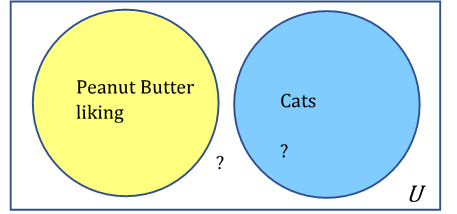Section 1.3 Describing and Critiquing Arguments
Objectives: Section 1.3 Describing and Critiquing Arguments.
Students will be able to:
Understand the structure of logical arguments by identifying the premise(s) and conclusion
Distinguish between inductive and deductive arguments
Make a set diagram to evaluate deductive arguments
Determine whether a deductive argument is valid and/or sound
Subsection 1.3.1 Logical Arguments
A logical argument is a claim that a set of premises support a conclusion. It is possible for a logical argument to have one or many premises, but there must be one conclusion. In this section we will look at types of arguments and how to determine the strength, validity and/or soundness of each type. There are two types of arguments we will explore in this section: inductive and deductive arguments.
Subsection 1.3.2 Inductive and Deductive Arguments
To better understand the difference between inductive and deductive arguments, let’s start by looking at a couple of examples.
Example 1.3.1.
Consider the following argument:
When I went to the store last week, I forgot my wallet, and I forgot it again when I went back today. I always forget my wallet when I go to the store.
Before we analyze an argument, it is helpful to precisely state its premises and its conclusion. Most arguments you encounter in the real world won’t be stated in a precise “premise, premise, conclusion” form. Sometimes the conclusion will be stated before the premises, or the premises will be hidden within a bunch of rhetoric.
To begin our analysis of this first argument, let’s first rewrite it in a more precise “premise, premise, conclusion” form.
Premise: I forgot my wallet when I went to the store last week.
Premise: I forgot my wallet when I went to the store today.
Conclusion: I always forget my wallet when I go to the store.
Notice that both premises make a claim about a specific instance – the specific instance last week when I forgot my wallet, and the specific instance today when I forgot my wallet. The conclusion, on the other hand, states what we can expect to happen more generally.
Now let’s consider a different argument:
Example 1.3.2.
Henry must know CPR because he is a nurse and all nurses know CPR.
Just as we did for the last example, let’s rewrite the argument in its “premise, premise, conclusion” form:
Premise: All nurses know CPR.
Premise: Henry is a nurse.
Conclusion: Henry knows CPR.
Unlike the first argument where the premises were specific and the conclusion was general, this argument’s first premise is a general statement and the conclusion is specific. We can determine whether an argument is inductive or deductive by looking at which part of the argument is general and which is specific. In the first example, the premises were specific and the conclusion was more general. This is an example of an inductive argument. In the second example, it was the premises that were more general and the conclusion that was specific. This is an example of a deductive argument.
In general, an inductive argument uses a collection of specific examples (i.e. data) as its premises and uses them to propose a general conclusion, while a deductive argument uses a collection of general statements (i.e. definitions) as its premises and uses them to propose a specific conclusion. You can see the difference in the pyramids below. We start with the premises at the bottom and build up to the conclusion.
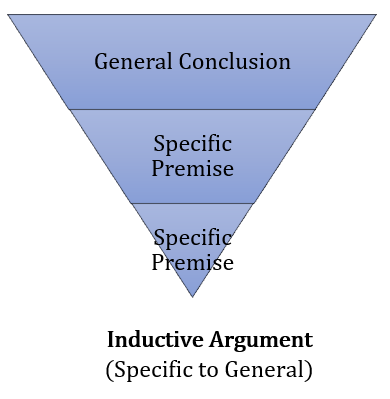
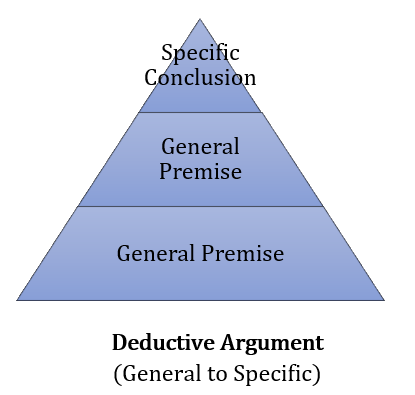
Example 1.3.3.
Rewrite the following arguments in a precise “premise, premise, conclusion” form, and determine if the argument is inductive or deductive.
A number is prime if it is only divisible by itself and one. Since the number 13 is only divisible by itself and one, 13 must be prime.
Juan’s dog Goober is having puppies. All three of Goober’s previous litters have had 5 puppies so Goober is bound to have 5 puppies in this litter as well.
-
Premise: If a number is only divisible by itself and one, the number is prime.
Premise: The number 13 is only divisible by itself and one.
Conclusion: 13 is prime.
Since the premises are general definitions and properties of numbers and the conclusion is a specific statement about the number 13, the argument is deductive.
-
Premise: Goober is having puppies.
Premise: Goober’s last three litters had 5 puppies.
Conclusion: Goober’s current litter will have 5 puppies.
This is an example of an inductive argument since it uses specific experiences/instances as its premises, and its conclusion is a general expectation based on those specific experiences.
Subsection 1.3.3 Evaluating Arguments
Inductive arguments cannot be proven. The best we can do is evaluate the strength of the argument based on the evidence it provides.
A strong inductive argument is one that is well supported by its premises, while a weak inductive argument is one whose premises do a poor job of supporting the conclusion. The strength of an inductive argument is subjective, because where one person sees a strong argument, another may see a weak argument. Additionally, the strength and truth of an argument are not necessarily related; it is possible to have a weak argument that is true, and a strong argument that is false.
Example 1.3.4.
Determine the strength of the inductive argument.
James Franco, Jodie Foster, Jennifer Lawrence, and Jack Nicholson have all won Academy Awards for acting. Actors whose names start with J are bound to win an Academy Award.
The inductive argument provides a number of specific cases as evidence for the conclusion. However, we would not be surprised if a J-named actor did not win an Academy Award, so the argument is weak.
Deductive arguments, on the other hand, can be proven and their validity and soundness can be evaluated. The validity of the argument is based on whether the conclusion follows logically from the premises, while the soundness of the argument is based on whether or not the premises are true. An argument cannot be sound if it is not valid, even if the premises seem reasonable.
Subsection 1.3.4 Evaluating Deductive Arguments Using Sets
One way to determine whether a deductive argument is valid is to illustrate the premises of the argument using sets and see if the conclusion logically follows if we assume the premises to be true.
Example 1.3.5.
Use a set diagram to determine whether the argument is valid. If the argument is valid, determine if it is also sound.
“All cats are mammals and a tiger is a cat, so a tiger is a mammal.”
“All water bottles are plastic. This is a water bottle, so it must be plastic.”
“All firefighters know CPR. Jill knows CPR, so Jill must be a firefighter.”
“None of my friends like dancing. Kai doesn’t like dancing. Therefore, Kai is my friend.”
“Some young adults make minimum wage and Tara is a young adult. Therefore, Tara makes minimum wage.”
-
First let’s write the argument in its “premise, premise, conclusion” form. For the problems we will be looking at, you will want to write the first premise as a qualified proposition (some, none, all) since this will form the basic structure of our diagram.
Premise: All cats are mammals.
Premise: A tiger is a cat.
Conclusion: A tiger is a mammal.
From the first premise we know that all cats lie inside the set of mammals (cats are a subset of mammals). From the second premise, we know that tigers lie inside the set of cats (marked with an X), and therefore also lie within the set of mammals.
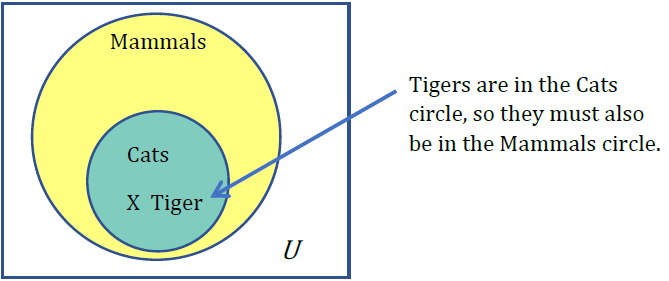
This argument is valid because we were able to show that the conclusion follows logically from the premises. The argument is also sound since the premises “all cats are mammals” and “a tiger is a cat” are true.
-
From the first premise we know that all water bottles lie inside the set of plastic items (water bottles are a subset of plastic). From the second premise, we know that this particular water bottle must lie within the plastic items set.
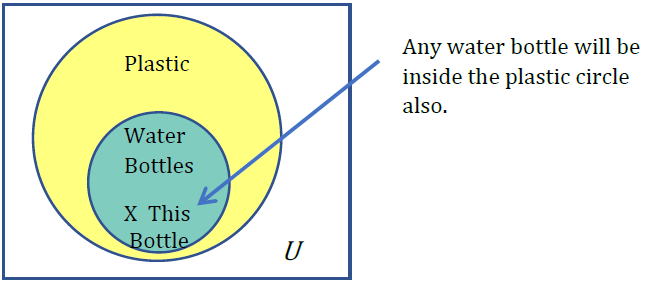
This argument is valid because we were able to show that the conclusion follows logically from the premises. But the argument is not sound because the premise that all water bottles are plastic is not true. There are many versions of glass and metal bottles that are evidence that the first premise is not true. This argument is valid but not sound.
-
From the first premise we know that all firefighters lie inside the set of those who know CPR (firefighters are a subset of people who know CPR). From the second premise, we know that Jill is a member of the set of those who know CPR, but we do not have enough information to know whether she is also a member of set of firefighters.
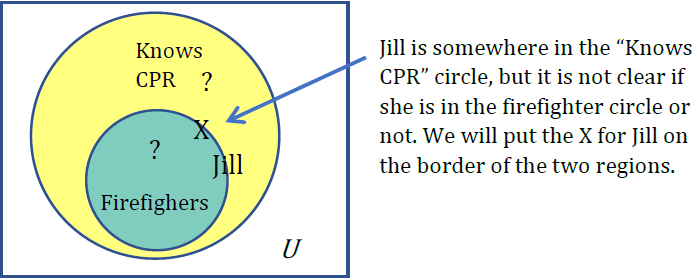
Since we cannot determine which group Jill must be a part of, the argument is invalid. The statement that Jill is a firefighter does not follow logically from the premises that “all firefighters know CPR” and that “Jill knows CPR”. Since the argument is not valid, it cannot be sound.
-
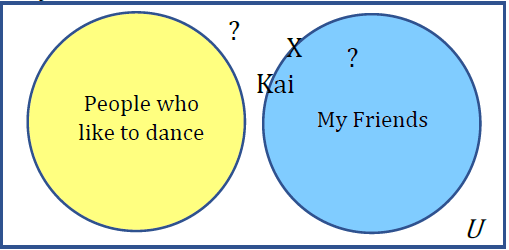
Because it said “none” we draw disjoint sets – one set for my friends and a second set for people who like to dance. The second premise tells us that Kai doesn’t like to dance so they’re not in the set of people who like to dance. However, we can’t put Kai in the set of my friends either. They could be my friend, or someone I don’t know who happens to not like dancing. Therefore, the conclusion is not valid. And therefore, the arguement is also not sound.
-
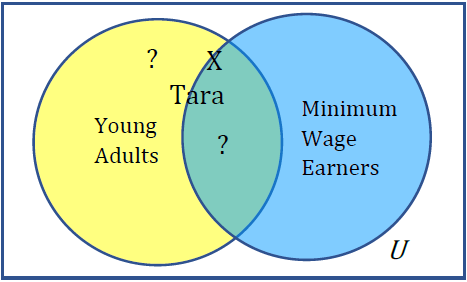
Because it said “some” we draw overlapping sets. The second premise tells us to put Tara in the set of young adults, but it doesn’t tell us if she makes minimum wage or not. So, like the previous example we cannot determine which region she is in. She could make minimum wage, or she could also make more. Therefore, the conclusion is not valid and therefore, not sound.
Exercises 1.3.5 Exercises
1.
Write whether the argument described is inductive or deductive:
The first five terms of the sequence were all odd, therefore the sixth term will also be odd.
My dog is afraid of loud noises. Today is the fourth of July, so there will be fireworks. My dog will be afraid today.
The argument is inductive.
The argument is deductive.
2.
Find the next term of the sequences below.
3, 6, 9, 12, 15,
3, 6, 9, 15, 24,
The next term is 18.
The next term is 39.
Rewrite each of the following arguments in their “premise, premise, conclusion” form, and determine whether the argument is inductive or deductive. If the argument is inductive, determine its strength. If the argument is deductive, use sets to illustrate and determine the validity of the argument, and state whether the argument is valid and whether it is sound.
3.
Since all cats are scared of vacuum cleaners and Max is a cat, Max must be scared of vacuum cleaners.
Premise: All cats are scared of vacuum cleaners.
Premise: Max is a cat.
Conclusion: Max must be scared of vacuum cleaners.
This is a deductive argument. It is valid. However, it is not sound because the premise all cats are afraid of vacuum cleaners is false. While many cats are afraid of vacuum cleaners not ALL cats are afraid. There are many videos of cats riding electronic vacuum cleaners.
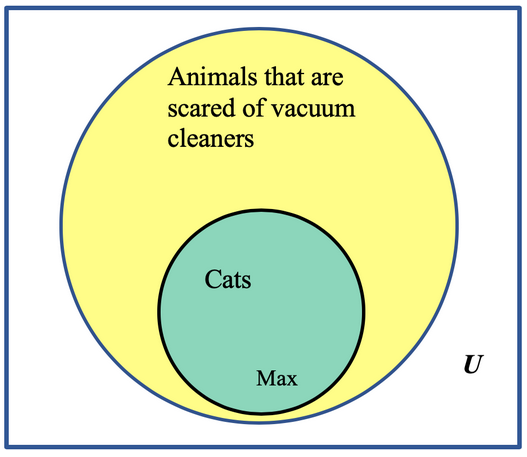
4.
Every day for the last year, a plane flew over my house at 2 pm. Therefore, a plane will always fly over my house at 2pm.
Premise: Every day for the last year, a plane flew over my house at 2pm.
Conclusion: A plane will always fly over my house at 2pm.
This is an inductive argument. It is a strong argument because a large quantity of data has been collected.
5.
Kiran collected data on the salaries of their friends. They found that female and nonbinary friends made less than male friends, so they concluded that women and nonbinary people make less than men.
Premise: Kiran’s female and nonbinary friends made less than Kiran’s male friends.
Conclusion: Women and nonbinary people make less than men.
This is an inductive argument. Kiran did not gather a large diverse sample because they only asked their friends. Therefore, their data has sampling bias. This makes their argument weak.
6.
Some of these kids are rude. Jimmy is one of these kids. Therefore, Jimmy is rude!
Premise: Some of these kids are rude.
Premise: Jimmy is one of these kids.
Conclusion: Jimmy is rude!
This is a deductive argument. This argument is not valid. Jimmy could be one of these rude kids, he could also be a kid who is not rude. Because the conclusion is not valid, it is also not sound.

7.
All bicycles have two wheels. My friend’s Harley-Davidson has two wheels, so it must be a bicycle.
Premise: All bicycles have two wheels.
Premise: My friend’s Harley-Davidson motorcycle has two wheels.
Conclusion: It must be a bicycle.
This is a deductive argument. The argument is not valid. Based on the premises, we know that the friend's Harley-Davidson motorcycle has two wheels, but we do not know whethere or not it is a bicycle. Because it is not valid, it is also not sound.
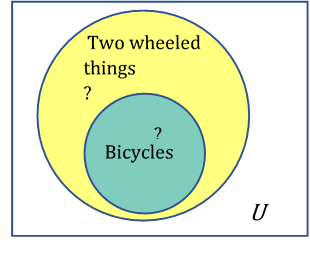
8.
Since all chocolate contains milk and this bar is made of chocolate, it must contain milk.
Premise: All chocolate contains milk.
Premise: This bar is made of chocolate.
Conclusion: It must contain milk.
This is a deductive argument. The argument is valid. This bar is in the set of chocolate and chocolate is in the set of things that contain milk. However, this conclusion is not sound because not all chocolate contains milk.
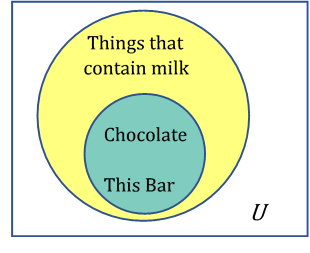
9.
All students drink a lot of caffeine. Brayer drinks a lot of caffeine, so he must be a student.
Premise: All students drink a lot of caffeine.
Premise: Brayer drinks a lot of caffeine.
Conclusion: He must be a student.
This is a deductive argument. The argument is not valid. We can not determine if Brayer is a student or not. Because it is not valid it is also not sound.
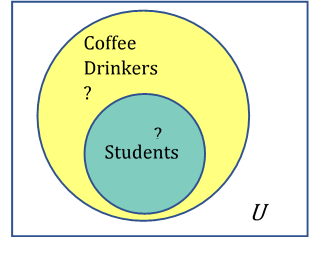
10.
Over the course of a year, data was collected on the number of students visiting the cafeteria. On average, there were 15-35 students present in the cafeteria during the peak hours of the data. We can expect there to be between 15 and 35 students in the cafeteria if we go during the peak hours of the day.
Premise: Over one year on average, there were 15-35 students present in the cafeteria during the peak hours.
Conclusion: There is going to be between 15 and 35 students in the cafeteria if we go during the peak hours of the day.
This is an inductive argument. This argument is strong because the conclusion is supported by the premises, they gathered a large amount of data over a long period of time on week days.
11.
If a person is on this reality show, they must be self-absorbed. Laura is not self-absorbed. Therefore, Laura cannot be on this reality show.
Premise: People on this reality show are self-absorbed.
Premise: Laura is not self-absorbed.
Conclusion: Laura cannot be on this reality show.
This argument is deductive. The argument is valid because Laura is outside of the set of self-absorbed people, so she must also be outside of this set of people on this reality show. Determining if this conclusion is sound is more difficult because determining if someone is self-absorbed is subjective.
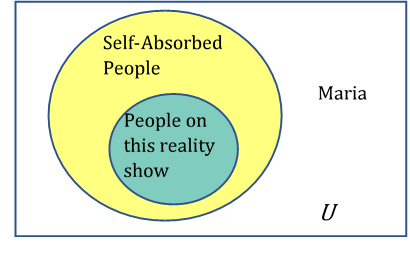
12.
The first few terms of the sequence are 1, 3, 5, 7, 9. Therefore, the next term will be 11.
This is a strong inductive argument because we are given specific numbers in which we can find a pattern. Then based on that pattern we can determine that the next term of the sequence would be 11.
For each of the following, draw the appropriate illustration of sets (Subset, Disjoint or Overlapping). Then put an X to represent the subject of the conclusion or put two question marks to illustrate the subject could into two locations. Finally, state if the argument is valid and whether it is sound.
13.
Premise: No apples are pears.
Premise: A Pink Lady is an apple.
Conclusion: Therefore, a Pink Lady is not a pear.
The argument is valid and sound.
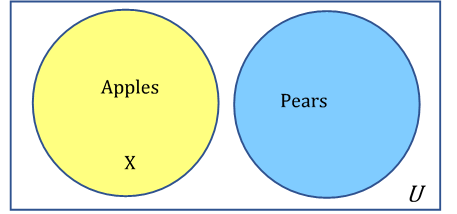
14.
Premise: All children are young.
Premise: Tamika is young.
Conclusion: Therefore, Tamika is a child.
The argument is not valid, and it is not sound.
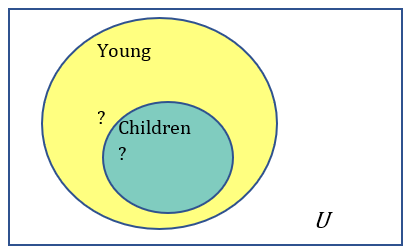
15.
Premise: Some goats faint.
Premise: Fizzy faints.
Conclusion: Therefore, Fizzy is a goat.
The argument is not valid, and it is not sound.
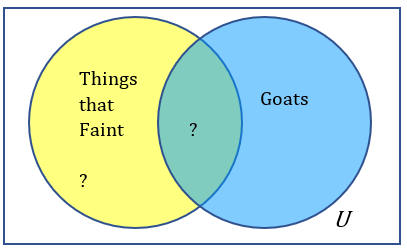
16.
Premise: All students who miss more than 25% of class time fail.
Premise: Claudia failed my class.
Conclusion: Claudia missed more than 25% of class time.
This argument is not valid, and because it is not valid it is also not sound. Claudia could have missed 25% of the classes causing her to fail. She could instead be failing because of low test scores.
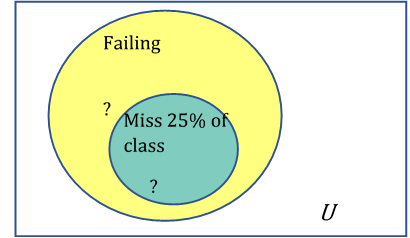
17.
Premise: All students who miss more than 25% of class time fail.
Premise: Ethan missed more than 25% of class time.
Conclusion: Ethan failed.
This argument is valid, and it is sound. Because Ethan is in the set of folks who missed 25% of the classes he also falls into the set of failing.
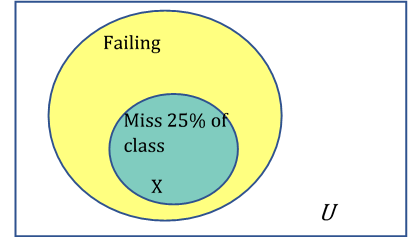
18.
Premise: All dogs eat apples.
Premise: Mary ate an apple.
Conclusion: Mary is a dog.
This argument is not valid, and because it is not valid it is also not sound. Mary could be a dog. Mary could also be a worm, horse or human.
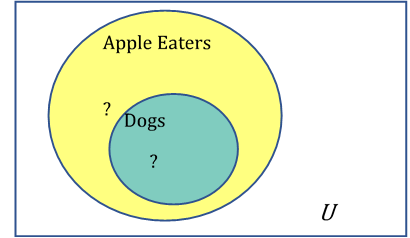
19.
Premise: Some entering freshmen have to take a placement test.
Premise: Juan is an entering freshman.
Conclusion: Juan has to take a placement test.
This argument is not valid, and is not sound. We cannot determine if Juan took the test.
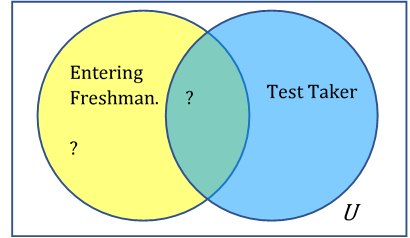
20.
Premise: No cats like peanut butter.
Premise: Bob does not like peanut butter.
Conclusion: Bob is a cat.
This argument is not valid. Because it is not valid, it is also not sound. We cannot determine if Bob is a cat or not.
